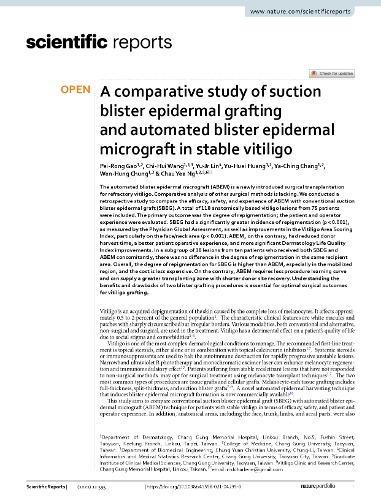Publications
- Home
- Publications
- Research Publications
- A comparative study of suction blister epidermal grafting and automated blister epidermal micrograft in stable vitiligo
A comparative study of suction blister epidermal grafting and automated blister epidermal micrograft in stable vitiligo

Abstract:
The automated blister epidermal micrograft (ABEM) is a newly introduced surgical transplantation for refractory vitiligo. Comparative analysis of other surgical methods is lacking. We conducted a retrospective study to compare the efficacy, safety, and experience of ABEM with conventional suction blister epidermal graft (SBEG). A total of 118 anatomically based vitiligo lesions from 75 patients were included. The primary outcome was the degree of repigmentation; the patient and operator experience were evaluated. SBEG had a significantly greater incidence of repigmentation (p < 0.001), as measured by the Physician Global Assessment, as well as improvements in the Vitiligo Area Scoring Index, particularly on the face/neck area (p < 0.001). ABEM, on the contrary, had reduced donor harvest time, a better patient operative experience, and more significant Dermatology Life Quality Index improvements. In a subgroup of 38 lesions from ten patients who received both SBEG and ABEM concomitantly, there was no difference in the degree of repigmentation in the same recipient area. Overall, the degree of repigmentation for SBEG is higher than ABEM, especially in the mobilized region, and the cost is less expensive. On the contrary, ABEM requires less procedure learning curve and can supply a greater transplanting zone with shorter donor site recovery. Understanding the benefits and drawbacks of two blister grafting procedures is essential for optimal surgical outcomes for vitiligo grafting.FAQ Classification
Related FAQ
- A comparative study of an advanced skin imaging system in diagnosing facial pigmentary and inflammatory conditions
- From zero to one: Recent advances in the pathogenesis, diagnosis, and treatment of vitiligo.
- Skin Interstitial Fluid and Plasma Multiplex Cytokine Analysis Reveals IFN-γ Signatures and Granzyme B as Useful Biomarker for Activity, Severity and Prognosis Assessment in Vitiligo
- Targeting the elevated IFN - γ in vitiligo patients by human anti - IFN - γ monoclonal antibody hampers direct cytotoxicity in melanocyte
- Pathogenic autoantibodies to IFN-γ act through the impedance of receptor assembly and Fc-mediated response
- Feasibility of Oral Tranexamic acid (TA) for Vitiligo Patients with Melasma
- Efficacy and safety of automated epidermal micrograft in patients with stable segmental and nonsegmental vitiligo
- Feasibility of High-Cellular-Resolution Full-Field, Artificial-Intelligence-Assisted, Real-Time Optical Coherence Tomography in the Evaluation of Vitiligo: A Prospective Longitudinal Follow-Up Study.
- Association of multiple sclerosis with vitiligo: a systematic review and meta- analysis
- Vitiligo associated with polycaprolactone-based collagen stimulator filler

